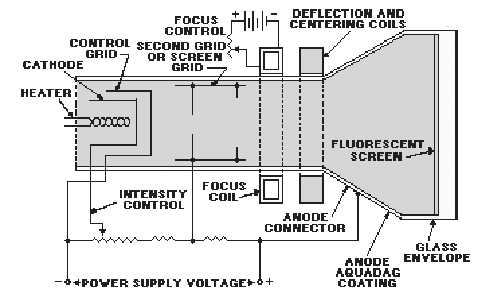3-7
VIDEO AMPLIFIER.—The video amplifier circuit amplifies the video signal from the receiver
and applies it to the crt intensity-modulating element (control grid).
POWER SUPPLY.—The power supply produces all voltages needed to operate the indicator. It
also includes protective devices and metering circuits.
Although not shown in the basic block diagram, many indicators contain circuits which aid in range
and bearing determination. These circuits are also synchronized by the gate circuit.
Sweep Deflection
In modern indicator systems, electromagnetic deflection of the crt electron beam is preferred to
electrostatic deflection. Reasons for this choice are (1) increased control of the beam, (2) improved
deflection sensitivity, (3) better beam position accuracy, and (4) simpler construction of the crt.
The primary difference between electromagnetic and electrostatic cathode-ray tubes lies in the
method of controlling deflection and focusing of the electron beam. Both types employ electron guns and
use electrostatic fields to accelerate and control the flow of electrons. The physical construction of a crt
employing electromagnetic deflection is similar to an electrostatic type. The construction of a crt
employing electromagnetic deflection is shown in figure 3-5.
Figure 3-5.—Electromagnetic crt construction.
The electron gun in figure 3-5 is made up of a heater, cathode, control grid, second or screen grid,
focus coil, and anode (composed of a special coating). Focusing the electron beam on the face of the
screen is accomplished by the focus coil. A direct current through the windings sets up a strong magnetic
field at the center of the coil. Electrons move precisely along the axis of the tube and pass through the
focusing field with no deflection. This is because they move parallel to the magnetic field at all times.
Any electron which enters the focusing field at an angle to the axis of the tube has a force exerted on
it that is perpendicular to its direction of motion. A second force on this electron is perpendicular to the
magnetic lines and is, therefore, constantly changing in direction. These forces cause the electron to move

